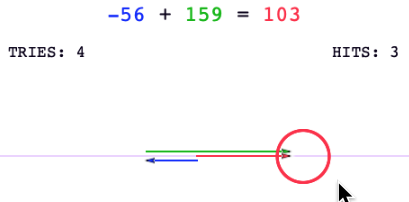Hi all,
I will discuss Reaching the Full Range at the Asilomar meeting of the California Math Council (Saturday, December 1, at 11am). I hope to see some of you there! See below for a brief summary of the topic, and check out the many related links on the Talks page on my Web site.
Speaking of my Web site, your old bookmarks should still work, but I have a new, shorter URL: www.mathed.page. Likewise, my blog is now blog.mathed.page.
On to the newsletter: first some philosophizing, then some games!

Spiraling Out of Control?
Spiraling is a way to improve retention, and to give students more time to absorb new concepts and techniques. The idea is that a single exposure to a given topic is often insufficient, so the topic should be revisited some weeks or months later. I know this to be true from experience, and I'm told that research supports the claim. Unfortunately, many approaches to spiraling push towards an atomized program which reduces the opportunities for in-depth work. Also, many overly-spiraled approaches to homework are hard to manage for the teacher, and many overly-spiraled curricula are opaque in their organization and make it hard to find materials on a given topic. I discuss these contradictions in a recent blog post.

Reaching the Full Range
Spiraling can be made easy for the teacher and effective for the student by implementing a number of non-traditional policies: lagged homework, humane assessment, and some unorthodox practices in the sequencing of topics. Combining these approaches yields a form of spiraling that is transparent and easy to implement. Because it is unit-based, it allows for in-depth work on each topic. Because it reduces time pressure, it communicates a growth mindset. Because it facilitates forward motion, it relieves teacher anxiety about coverage. I have written about all this in multiple blog posts over the years, but I finally put it all together into one article: Reaching the Full Range.
(See also a three-page summary and practical guide to implementation of parts of this scheme, here.)
These structural policies are useful when teaching a heterogeneous class (i.e. any class.) They help to achieve constant forward motion and eternal review. They are rather easy to implement, and give a lot of bang for the buck, but they only constitute part of what is needed to "reach the full range." Other ingredients are in the choice of curriculum (use of rich problems and activities), in a classroom organization that includes discourse-enhancing routines and group work, and in a tool-rich pedagogy to support multiple representations and to liven things up.
Words of Wisdom :)
Check out a short new blog post (More Catchphrases), largely addressed to beginning teachers, where I elaborate on three slogans: (a) Trust your intuition, avoid dogma, be flexible, be kind; (b) You are as important as your students; and (c) When grading, you are working for one student — when planning, you are working for the whole class. It's a sequel to my Catchphrases post from last summer.
On the Desire to Push Kids Ahead
This is a guest post by Rachel Chou, Math Department Chair at Menlo School in Silicon Valley. I wrote about this topic on my Web site, under the title Hyper-Acceleration. You’ll see that Rachel addresses a particularly acute version of the problem, because she is in a private school in a region where hyper-acceleration is deeply embedded in the culture of privileged parents. Even if the situation at your school is not as extreme, you might get some ideas from Rachel on how to discuss this non-confrontationally with concerned parents or the administrators they pressure.
